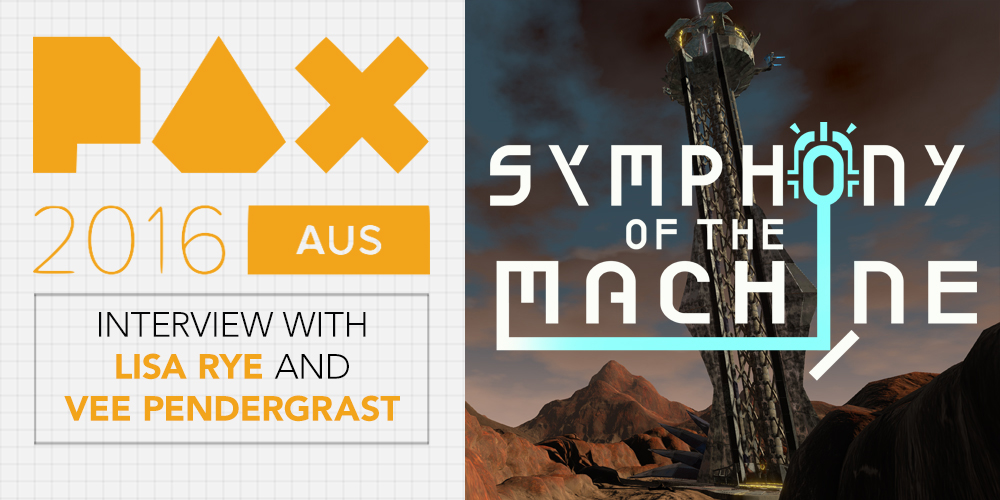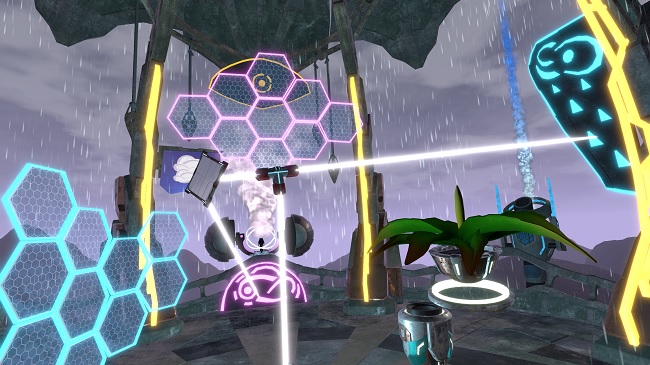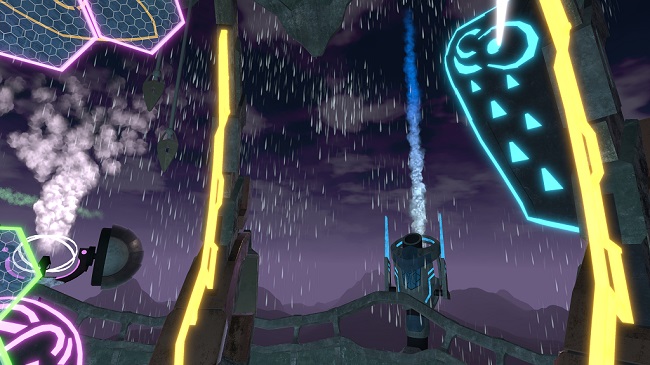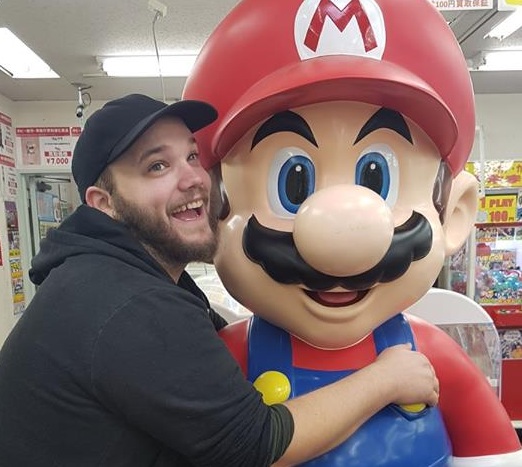
I like the idea of VR, but there hasn’t been a lot of games using it to convince me of its viability. For one, I wear glasses and largely need them to not only see clearly, but to stop my brain from feeling like it’s dissolving in acidic jelly. Wearing glasses with a headset on is uncomfortable at best, and this is to say nothing of the motion sickness issues that I, along with many others, currently experience with VR. Symphony of the Machine is a game that uses some fairly clever design to get around a lot of these issues, while still delivering on the promise of immersion that VR inherently brings to the table. I’m still not totally convinced about VR, but Symphony has made its future look a little brighter. During PAX, I spoke with Lisa Rye and Vee Pendergrast about the development of the game, and what it’s like to work with VR.

So, where did the idea start?
Lisa: We actually started this at a game jam at the beginning of the year, and it had a theme of rituals, which we used to come up with the concept of the rain dance. So, the core idea of the Symphony is bringing this wasteland back to life, you’re in this mysterious tower, and you have to use the machine in there to change the weather around you. Because it’s in virtual reality, you get to experience the weather first hand, so it’s about the feeling of actually being in a storm, or watching the wasteland first hand as it comes back to life.
Is there a narrative in the game, some kind of story that’s weaved into it as the Wasteland comes back to life?
Lisa: The idea is that the story is being told by this landscape around you, so there will be some cave paintings in the very starting area, which will give you an idea of the land you’re in.
So the meaning of it is largely left up to player interpretation?
Lisa: Yeah, definitely about player interpretation
You said it started as a game jam title, did it start there as VR, too?
Lisa: It did, actually, we wanted to challenge ourselves, it was definitely tough – 48 hours, but we managed to get a working prototype that we were extremely happy with in the time that we had.

That must have been crazy getting that together. What was it like by the end of the game jam?
Lisa: It was a playable demo, we were even able to bring that same demo to an open playtesting room, and they all had a great time. You don’t expect to have a super polished experience from a game jam game, but we were really happy with the results.
Being one of the main artists of Stirfire, so where did you take influence for the visual tyle from? I feel like there’s this weird kind of mechanical nature vibe happening in the game.
Lisa: Yeah, exactly, I kind of think of the tower as being this mechanical temple, it’s kind of a foreign thing to you, you don’t understand it, and you’re in this other world that you don’t really understand, even if parts of it feel familiar. So it’s that contrast between what you don’t understand, and the natural world outside, which I think Symphony’s key points.
Has the direction of the game changed at all since game jam, or has it just been this one idea that you’ve been refining the whole time?
Lisa: It’s absolutely changed since game jam, our original game jam game was much more simple – you pressed button, and things happened. We wanted to take a more tactile approach, which is why we brought in the light beam that you physically interact with using the mirrors and splitters. That was definitely the biggest change since the original prototype, bringing in that sort of motion controller interaction with the game.
What’s it been like developing for VR, and trying to get it to the smooth kind of experience that it is at the moment? Was it a difficult process?
Lisa:Oh wow, it’s definitely an interesting experience working with VR. You end up developing a weird affinity with it, because you’re going in and out of VR the whole time in your working life. You end up with sort of connection to the world that you’re making, and seeing the objects that you create as 3D models go directly into the game, it’s a fantastic experience being able to pick them up and move them around.

A lot of problems of VR stem from the dissonance between in-game motion versus standing still as the player, so was being largely static in the game a deliberate part of the game’s design?
Lisa: Well, there is movement through teleporting, but we definitely kept it as user friendly as possible. We have VR sensitive members of the team, and we really wanted it to be a game that even they could play, so that it was accessible for all people. There are so many games out there which are super intense, shooting games, moving games, VR is just a really intense experience. So, Symphony is all about zen, calm, take your time, enjoy yourself and experience it how you want to experience it.
Vee: You can play this game seated, that was very deliberate, and again it’s because we were thinking about accessibility. The teleport mechanic is your locomotion, we tried a few different methods and found that was the most friendly. It reduces motion sickness, and allows people with mobility issues to move in-game. You’ll notice when you do teleport, it’s like your eyes are closing, and that was a deliberate design idea to reduce motion sickness.
As someone normally afraid of heights, it was really cool being able to look over the side of the elevator at the start and see down to the ground. Have you had anyone describe any weird feelings of vertigo, or something similar, because of that?
Lisa: We were concerned about the lift sequence, so we’ve done extensive testing with people who are VR sensitive and height sensitive, and everyone reacts in different ways to that part. Most people go, “Wow, this is so cool, I actually feel like I’m in a lift,” you do get some people who freak out from the height and sort of step back, but they still enjoy the experience. You still have that kind of disconnect going, “I know I’m safe, I know this is scary, but I’m moving and seeing this amazing landscape.” It definitely has been interesting seeing the different responses to that, but for most people it’s been fine.
Is there anything that still needs to be done for the game before it’s released?
Lisa: We’re putting in new content, and expanding out tutorial section, mostly just making sure that players have a smooth experience and transition from one part of the game to the next.
While playing, I did have Amos speaking through a headset as this disembodied voice, teaching me how to play the game, are you planning on having something like that in the game for the tutorials?
Lisa: We want to stay away from voiceovers, because we think that would subtract from the theme of it. What we’re essentially trying to do here at PAX is to compress what would normally be about twenty minutes of gameplay into ten or less. So, that’s why we’ve got our team members talking people through at PAX because we are referencing games like The Witness and The Talos Principle, we don’t want to simply be telling you what to do. We want players to have that moment of, “Hey, I figured it out and I’m really happy about this.” So, there’ll be a mix of that, more tutorial tips from the robot, and some other stuff to help you along.

So, it’ll be more like a zen puzzler, as opposed to a zen walking simulator?
Lisa:Yeah, that’s definitely the idea.
This is also going to be one of the first PSVR games, right? What was that process like?
Lisa: Yes, we’re actually releasing in quarter one next year.
Vee: When it was rapidly prototyped at the global game jam, straight away we knew we had something, and we knew we couldn’t leave it alone. So, we followed through, sent it to our friends at Sony who said they liked it, said that they didn’t have anything like it that was coming out on Playstation VR, and there was a gap in the market for puzzle games anyway. But we also got a big list of feedback, we then acted upon that feedback, redesigned the game into what it looks like currently, and that’s where the business really started. I went hunting for funding, the good thing was that we already had something in the pipeline and we were able to secure it because this was really exciting. Then there was the redesign process, watching that taking place, all while I secured the funding – we went through Stride PR for our media company, as well, they have a really great track record. We released our trailer a couple of weeks ago, and watching that zip around the world was a really fulfilling experience if you’re a marketing person.
You’re using the Vive here for the demo, so will it be PSVR exclusive, or will you be releasing on PC, as well?
Vee: Currently we’re developing for Playstation VR, and Vive through Steam VR, and that’s where our aims really lie. It’ll be across both of those platforms.
You guys started this at the beginning of the year, what’s it been like going from game jam prototype to full blown game inside of twelve months?
Vee: Hectic, is the word. The development team have been really hard at it, we did have a gap in there because we were hunting for funding, but then from mid-year onwards we’ve been full bore with this production. Continuous feedback, lots and lots of playtesting, and as you can see the production is really polished now, we’re really proud to show it off at PAX Australia this year. I think this is the proudest I’ve ever been of my team.
Something that I think is important to mention is that VR has an accessibility problem. As we both just discussed, both of us get motion sickness within VR, neither of us get that within Symphony of the Machine. But it goes further than that because VR has problems when it comes to people with mobility issues, or people who might not be as tall as the average. We have spent a lot of time reducing those problems, and making this a game for everyone as much as we possibly can. This game can only exist inside of VR, but so long as you’re capable of moving one controller and moving your head around you can play this game. So, if someone is in a wheelchair, or if someone has other issues, we have been very cogniscent of that in the development of this game.

You guys have also got Debug going at the moment, so what’s it been like juggling multiple projects?
Vee: Well, Symphony is, of course, taking the front seat at the moment, and we’re currently docused on getting that released in quarter one next year. Debug is currently sitting in alpha, there’s a playable demo here, a prototype, and we’re playtesting that now. We’re still working on that, but Symphony is definitely where our focus lies for the moment.
Just while we’re on the topic of Debug, where did the idea for that project start?
Vee: That was, again, one of Lisa Rye’s fabulous ideas. Lisa loves platformers, and she loves puzzle games, and she wanted to build something that became both in a way where thare are no actual rules, you choose how to solve the puzzles. The idea was to hand the player a toolbox of bugs; during the development of Freedom Fall we encountered a bunch of bugs, because that’s what development is like. So for Debug, instead of throwing that away, we wanted to embrace that and make that part of the game, so that’s where the inspiration came from.
The art style is very stylised, as well. It has a sort of pixel style without quite being pixel style, was that Lisa’s influence, as well?
Vee: Yeah, Lisa did the artwork for it, so it was always going to be amazing, there’s just no way around that. Aztec, meets Mayan, meets The Matrix, meets Blade Runner, there’s so many different elements and it has a really unique look to it.
So with Symphony of the Machine nearly done, and Debug in alpha, what is Stirfire going to be working on next?
Vee: Right now it’s a bit difficult to see past Symphony, we’re concentrating on that, and Debug in alpha, of course. We do have something else in mind, but I’m still not talking about that yet.

You still have that secret project!?
Vee: We still have that secret project.
I’m on tenterhooks, what is this project? Can you give us a hint?
Vee: Yeah – you’ll be waiting a little while.
Here are some other places where you can show your support for Symphony of the Machine:
Twitter: https://twitter.com/stirfirestudios
Studio: https://dev.stirfire.net/
Website: https://symphony.stirfire.net/
Facebook: https://www.facebook.com/SymphonyOfTheMachine/











